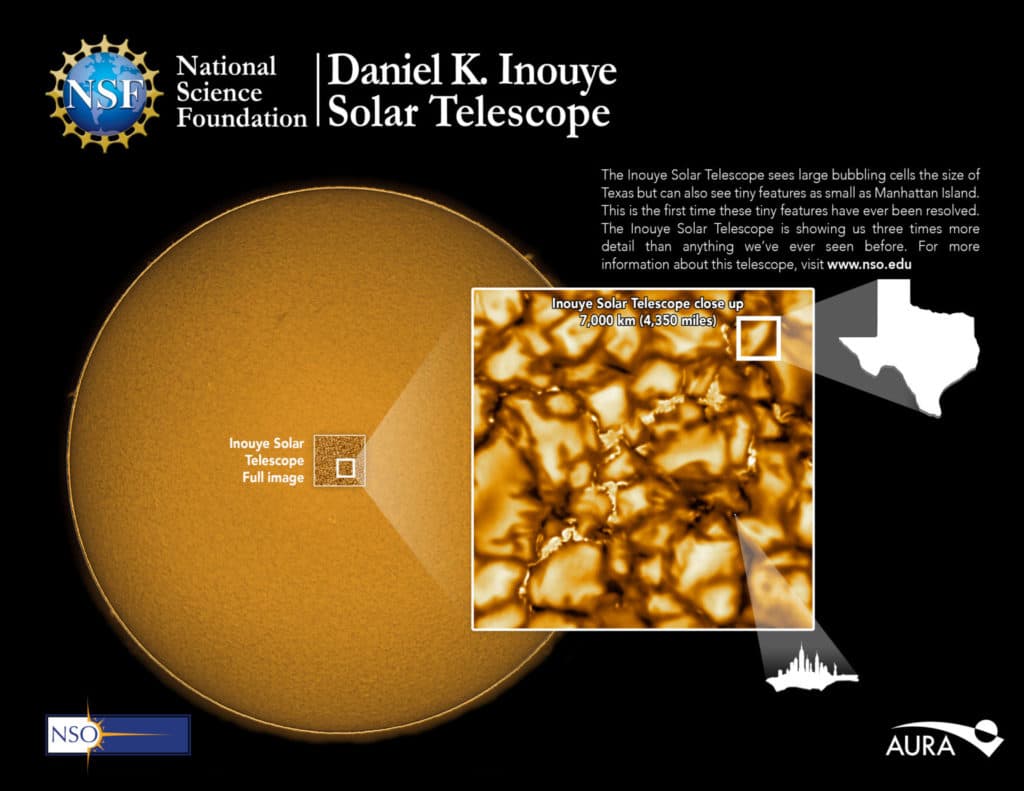The National Science Foundation’s Daniel K. Inouye Solar Telescope is the most powerful solar telescope in the world. The telescope recently captured a close-up view of the Sun’s surface.
The images show a pattern of turbulent “boiling” plasma that covers the entire Sun. The cell-like structures — each about the size of Texas — are the signature of violent motions that transport heat from within the Sun to its surface. That hot solar plasma rises in the bright centers of “cells,” cool off, and afterward sinks underneath the surface in dark lanes in a procedure known as convection.

France Córdova, NSF director, said, “Since NSF began work on this ground-based telescope, we have eagerly awaited the first images. We can now share these images and videos, which are the most detailed of our Sun to date. NSF’s Inouye Solar Telescope will be able to map the magnetic fields within the Sun’s corona, where solar eruptions occur that can impact life on Earth. This telescope will improve our understanding of what drives space weather and ultimately help forecasters better predict solar storms.”
The Sun—the heart of our solar system—is a yellow dwarf star, a hot ball of glowing gases. Its gravity holds the solar system together, keeping everything from the most significant planets to the smallest particles of debris in its orbit. Electric currents in the Sun generate a magnetic field that is carried out through the solar system by the solar wind—a stream of electrically charged gas blowing outward from the Sun in all directions.
Solar magnetic fields continually get twisted and tangled by the motions of the Sun’s plasma. Twisted magnetic fields can prompt solar-based storms that can adversely influence our technology-dependent lifestyle.
Resolving these tiny magnetic features is central to what makes the Inouye Solar Telescope unique. It can measure and characterize the Sun’s magnetic field in more detail than ever seen before and determine the causes of potentially harmful solar activity.
Thomas Rimmele, director of the Inouye Solar Telescope, said, “It’s all about the magnetic field. To unravel the Sun’s biggest mysteries, we have to not only be able to see these tiny structures from 93 million miles away clearly but very precisely measure their magnetic field strength and direction near the surface and trace the field as it extends out into the million-degree corona, the outer atmosphere of the Sun.”
David Boboltz, program director in NSF’s division of astronomical sciences and who oversees the facility’s construction and operations, said, “These first images are just the beginning. Over the next six months, the Inouye telescope’s team of scientists, engineers, and technicians will continue testing and commissioning the telescope to make it ready for use by the international solar scientific community. The Inouye Solar Telescope will collect more information about our Sun during the first five years of its lifetime than all the solar data gathered since Galileo first pointed a telescope at the Sun in 1612.”
NSF’s new ground-based Inouye Solar Telescope will work with space-based solar observation tools such as NASA’s Parker Solar Probe (currently in orbit around the Sun) and the European Space Agency/NASA Solar Orbiter (soon to be launched). The three solar observation initiatives will expand the frontiers of solar research and improve scientists’ ability to predict space weather.
